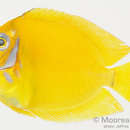Diagnostic Description
provided by Fishbase
Purplish black in color; an orange diffused patch at edge of gill opening, just above pectoral fin base; a broad black band from upper end of gill opening to margin of gill cover down to isthmus; caudal spine socket with a narrow black margin. Blackish lips; a trace of orange behind eye; a white line under chin extending slightly above rictus. Gill rakers on anterior row 23-26; on posterior row 25-27. Juveniles can exhibit 3 different color patterns mimicking Centropyge species. Caudal fin rounded in juveniles.Description: Characterized further by having length of caudal spine about 2.5-4.5 in head lengh; greatest depth of body 1.8-2.0 in SL (Ref. 90102).
- Recorder
- Estelita Emily Capuli
Morphology
provided by Fishbase
Dorsal spines (total): 8; Dorsal soft rays (total): 27 - 30; Analspines: 3; Analsoft rays: 24 - 28
- Recorder
- Estelita Emily Capuli
Biology
provided by Fishbase
Occurs in lagoon and seaward reefs; prefers areas of mixed coral, rock, or sand at the base of reefs or ledges, Ref. 48637. Also on silty reefs (Ref. 9710). Found singly (Ref. 9710). Juveniles mimic Centropyge spp. (in Guam, juveniles mimic C. flavissimus but in Palau where this species is absent, they mimic C. vrolikii), Ref. 48637. Presence of a venom gland could not be determined despite the presence of distinct anterolateral grooves; this may be due to the loss of venom glands in adults (Ref. 57406). Feeds on algae (Ref. 89972).
- Recorder
- Estelita Emily Capuli
Importance
provided by Fishbase
fisheries: commercial; aquarium: commercial
- Recorder
- Estelita Emily Capuli

